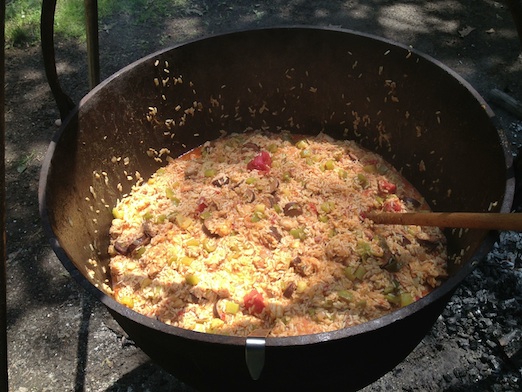Making 50 servings
Multiply family serving size quantities by 5, so:
-
1¼ lbs bacon
5 lbs smoked Andouille
20 oz peanut oil
6¼ lbs skinless, boneless chicken thighs (see notes)
4 lbs onions
4 lbs green pepper
5 lbs celery
20 cloves garlic
½ cup + 2 Tablespoons commercial Cajun spice
½ cup + 2 Tablespoons smoked paprika
3 Tablespoons Worcestershire sauce
9 lbs converted rice
at least 368 fluid oz (about 23 lbs) low sodium chicken stock (see notes)
10 lbs tomatoes (canned preferred)
5 lb headless fresh shrimp, deveined and shelled
Special equipment
- oh, that 25-40 gallon cauldron, again
a tight-fitting lid (see notes)
enough firewood to keep the kettle simmering for 2-3 hours
water to extinguish the blaze and cool the ground
Special Instructions for quantity cookery
- The challenge here is in the timing: you’re cooking a huge amount of rice, and when it’s ready, you have to serve. Cook it any longer, and it turns to mush. But it’s not difficult if you use these techniques:
- Once you’ve browned your meats and vegies, you want a low, even heat, so hang the kettle high: 16-18 inches from the ground
- Keep stirring to prevent the rice from scorching and sticking to the kettle. This is in direct conflict with the command never to open a cooking pot of rice, but so be it. The fear of scorching rice will make you anxious enough to check on that pot often and stir. Opening the lid so frequently will delay the cooking time, but you can have this dish ready from ignition of the kindling to charging serving platters in 2 to 2½ hours.
- Prep all your ingredients ahead of time (slice the meats, chop the vegies, measure the spices), and you can pull this off on five easy steps:
- Brown the chopped bacon and cut sausage in 10oz of the oil over a higher heat.
- Toss in the chicken pieces, and stir till browned.
- Reduce the heat by scattering the coals a bit and toss in the vegies, spices, and Worcestershire.
- When the vegies have begun releasing their liquids, stir in the rice, coating as much as possible. Add remaining oil if it looks dry.
- Add broth, shrimp, tomatoes; stir and cover.
- As soon as the rice tastes done, extinguish the fire and cool the ground, or, ideally, pull the cauldron off the flame and set it aside .
Notes
- Unless you want to punish the scullery boy, buy boneless skinless chicken thighs. You’ll save yourself quite a bit of time and effort not having to bone and skin the meat yourself.↩ Have lots of spare broth onhand. Depending on how much steam you let escape by opening to stir the contents, you may need to add more liquid. And once the dish is cooked, you can cool it down with extra broth as you’re serving.↩
The lid is a requirement; you cannot steam rice without it. We’ve seen conical lids made out of sheet metal, pricey steel lids, and rough plywood lids. We had ours custom made by a local tinsmith who was intrigued by the challenge. It fits perfectly, so it seals regardless of whether the bail (handle) is up or down. He gave it extra structure by welding a ring around the interior perimeter.↩
If you saved all those shells and made some seafood broth with them, you could substitute some of the homemade broth for the chicken broth next time.↩
Suggestions
- Our testing crew so enjoyed partipanting in the sampling that they insisted they get dibs on any leftovers, so bring some extra quart containers to reward them for their efforts in prepartion.
Don’t forget some beer for the chef! This is hot work.

